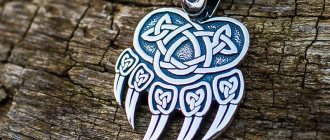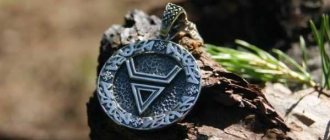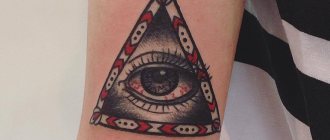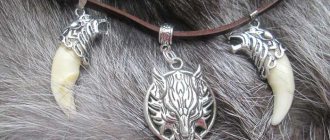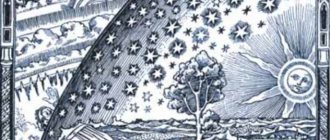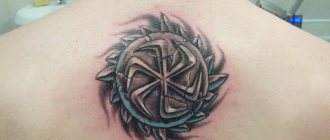According to Old Slavic mythology, Veles was a beast god, although his influence on other areas of people's lives is obvious. He cannot definitely be considered the patron saint of animals only. He was also the patron of hunters, traders and the god of wisdom. At a later time, his name became firmly associated with magic and secret sciences. Already at that time, an image with this god was made and worn as a talisman. The Veles tattoo now enjoys the same popularity and is applied to the skin, most often as a talisman.
Myths associated with the origin of Veles
God Veles
One of the most famous legends about the origin of this deity is closely intertwined with folk tales. The god Svarog had no children. His wife turned to the wise Makosh for help. On her advice, Lada went to Smetanoye Lake, the Garden of Eden. I caught a pike from the white waters. I cooked the magic fish and had it for lunch, and threw the leftovers into the field. The Zemun cow was grazing in the meadow and had eaten the bones. According to ancient Slavic myth, our Galaxy and the Milky Way originated from the milk of this heavenly creature. After some time, Lada and Svarog had three daughters. Veles was born to the divine cow - half man, half bull. He was endowed with the gift of sorcery, could change his appearance and appeared before the Gods in the form of a bear. He became the patron saint of the animal world, shepherds and hunters.
According to another legend, Veles was created by the Rod himself, who created the kingdom of heaven and earth. He took a piece of primary matter and breathed new life in the guise of Veles. The deity was given the opportunity to know the secrets of two opposite worlds - good and evil. He is endowed with power, strength and wisdom, and therefore was especially revered by the Slavs. They were depicted as a mighty, long-bearded old man holding a staff in his hands. Not forgetting the original appearance, there was a bear nearby. Our ancestors believed that this animal was favored most of all by the werewolf god. According to ancient belief, the bear's footprint is the seal of Veles. A similar sacred symbol became one of his personifications.
What does the seal look like?
Veles symbol
Worshiping powerful unknown forces, our ancestors created magical sketches and amulets as the earthly embodiment of the deity. It was believed that through such objects an energetic connection with the Almighty was carried out. The most famous symbol associated with Veles is an inverted letter "A", or arrowhead. One of the opinions is a simplified symbol of a bull’s head; a werewolf god could turn into this beast. Peasants often painted such a sign on the gates of barns, near pastures, to protect livestock from evil spirits.
Veles is also the patron saint of travelers, artisans, and merchants. Sometimes he was called the Guide of all Paths. Another interpretation is a cup, a symbol of prosperity and wealth. As you can see, the effect of the amulet is multifaceted, since it is the personification of a powerful ancient Slavic god.
Beliefs of the ancient Slavs
The bestial god is how Veles was often called. However, he was not only the patron of cattle breeders. Veles was considered the only one who knew both the forces of light and the forces of darkness. Therefore, he possessed wisdom inaccessible to any other god, not to mention humans. God Veles was the patron of sorcerers, a werewolf who commanded wild animals.
Ancient Slavic sources mention Boyana, a famous singer. He is called the grandson of Veles. Therefore, it is believed that he also takes care of people with strong creativity.
Despite all his positive qualities and power, Veles was expelled first from Prav, where the gods live, and then from the world of people, as a result of which he had to go to Nav. The reason for this is enmity with Perun , from whom Veles stole his wife. Yes, even the gods are not alien to human passions. According to one version, the werewolf kidnapped the goddess Dodola; according to another, she herself was not averse to leaving her husband. Perun returned his wife and punished him, and expelled Veles from the divine world. However, from the union of Dodola and Veles, the solar god Yarilo was born.
Then the great sorcerer went to wander among people and began to teach them all kinds of crafts. However, later he was expelled from the human world to Nav, where he took another wife.
From this story we can conclude that the attitude towards Veles was ambiguous: he was revered for his wisdom, but they were afraid of his power, which appeared as a result of the fusion of light and darkness.
Variety of signs
The Veles sign in the shape of an inverted letter “A” is not the only image and each carries its own sacred meaning:
- The seal is the personification of power and might.
- Triglav - promotes the development of creative potential.
- Coil - protects from evil spirits and theft.
Symbolic amulets are often supplemented with some images, which will change the effect and purpose of the magical item.
- Sword, warrior armor.
- Bird - sometimes depicted as a companion of Veles.
- Staff.
- Shepherd's horn.
- Horns, buffalo head.
The influence of Slavic signs on human life
Ancient Slavic symbols, made in the form of a tattoo, play a positive role, for example:
- improve health and increase immunity to most diseases;
- provides protection from dark forces and black magic;
- allow you to reveal hidden creative potential and the ability to create;
- improve physical endurance;
- make a person more balanced and peaceful;
- increase life expectancy;
- contribute to the achievement of set goals;
- allow you to establish a spiritual connection with the world around you and live in harmony with it.
Bear paw - meaning
Bear Paw
In Slavic mythology, it was the bear that most often became the second image of Veles. In this image he appeared to a person, which foreshadowed good luck in business and prosperity. The paw of this animal was a harbinger of good beginnings. The Slavs believed that in this way God declared his presence. The likeness of a paw is the Seal of Veles amulet, one of the most powerful Slavic talismans. A person protected by such a sign confidently moves towards his goal. In modern life it is recommended for traders. Contributes to the conclusion of profitable deals and stable profits.
The seal of Veles Bear's paw serves as protection against dark witchcraft forces. The powerful energy of the amulet will put up a reliable shield. In addition, the owner of the amulet is able to realize magical powers. If a child wears the Bear Paw amulet from early childhood, he develops intuitive abilities that help him avoid unpleasant life situations. The ability to predict future events appears. For travel enthusiasts, the protection of this talisman is essential. Its energy will protect you from troubles along the way. Seal of Veles The bear's paw was popular among merchants as protection against robbers. It was believed that the evil intentions of dashing people were destroyed by the energy emanating from the amulet. Esotericists say that under the influence of the magic of the amulet, the qualities inherent in a bear develop. A person becomes decisive, quickly achieves his goal, feeling like a master.
Wolf paw - meaning
Wolf paw
The question may arise: “Is this a mistake?” No, it’s not a mistake - this amulet exists. It differs from the Bear Track in that it has four toes. A wolf's footprint is exactly like this, while a bear leaves a five-fingered print. According to legend, the wolf is one of the forms of the werewolf god. In this guise he sometimes appeared to people, so the trace was considered a good harbinger. The Veles Wolf Paw seal had a slightly different interpretation among the ancient Slavs. This is due to the difference in the habits of these two animals. This amulet is recommended for those who strive for freedom and independence. It will help shape the character of a leader. You can rely on such people in any situation; they will protect without knowing fear. Otherwise, the Seal of Veles Wolf's Paw has the same meaning as a bear's paw.
Slavic tattoos and their features
The distinctive features of Slavic tattoos include:
- They have a close connection with Celtic and Scythian ornaments. As for the Slavic ornament, these are interconnected dots, commas, rhombuses, crosses and spirals. Later, the Slavic ornament was supplemented and drawings of flower garlands, hearts, crowns and plant-themed patterns appeared.
- To create a tattoo, plots, motifs and images of characters from Russian fairy tales, songs and folk epics are used.
- The composition is often supplemented with a book ornament, which interweaves primordially Russian and Christian traditions in the set.
- Slavic tattoos often include elements of painting by famous Russian artists, for example, Vasiliev and Vasnetsov. An equally popular idea is body painting under Khokhloma, Gzhel or Palekh.
- Among modern Slavic tattoos, amulets, runes and deities, as well as stylized images of a dragon and a lion, are especially popular.
Amulet activation
Just because you purchased or made this item with your own hands does not mean that magic will happen. The energy of Veles will touch you when it is really necessary and your thoughts are aimed at good. It is important to know that any purchased talisman must first be cleaned and then activated. Why do you need a cleansing ritual? You do not know the master who made the item, his thoughts are unknown. Before you got the talisman, it passed through many hands. Perhaps at some stage your future amulet has absorbed negativity. To get rid of this, the object is placed on salt for a while. Used crystals are thrown into the fire. Then take the talisman in your palm, warm it with the warmth of your hands and breath. The object should “get used” to you, feel the aura of the body. You can read conspiracies, and you don’t have to know the texts. Your words spoken with faith in the power of Veles are enough. The activation ritual is completed - the amulet can be worn. Some sources have information that holy water is used for cleaning, but this issue is quite controversial. It is known that the Christian church negatively perceives pagan rituals.
Veles and his Love. What's going on with this Slavic holiday?
In nature, Veles awakens a feeling of love, a feeling of the strongest, but such a pleasant confusion of the soul! And everything in nature awakens to this love! And it’s not for nothing that Veles is called a sorcerer - after all, anyone who fell under his spell could not resist. The power of the mighty Veles was not only destructive for those who fell into his power, but also healing - after all, who but Veles will guide you on the right path and help with wise advice?
This is where his mystery and captivity lies! Veles can lead a person out of any darkness and any trouble, both in serious matters and in the love of an unhappy person he will guide him to the true path. This often happens to people at the Slavic holiday of Veles Strecha.
Do you know that Veles has his own love story? A story about eternal love, in which there is tenderness, self-sacrifice, and a creative force that unites for all times. Everything is beautiful in this story - the power of love, the pain of parting, and the joy of meetings. He met his love on his way by chance and immediately recognized it as his own. Veles and his Yaginya - perhaps this is the only story in the Slavic epic about the eternal power of love.
This is how it is in life - those who receive the protection of the great God, find their love dreamy, romantic, passionate, sensual, and achieve it with all their might. This wonderful holiday, when winter rages and spring timidly hides, gives the Slavs exactly this feeling of strength, hope, love.
Because of the strange story of his birth, everyone imagined Veles differently. Some as a wanderer with a staff, some as a sorcerer bear, some as barefoot youths traveling through towns and villages. To whom he appears wise, thinking and knowing
God, and to whom a cheerful, perky young man with a wild character. But all these definitions cannot stand up to how important God is for people. And on February 11th we need to remember this and celebrate this holiday!
Veles can control events without becoming attached to something material, without being tempted by jewelry; knows better than anyone that money in the world is nonsense compared to real feelings; knows that what is truly valuable is not valued by anyone in the world. He, who has seen the dark and bright sides of life, knows that making mistakes is not a sin, but that you can learn from them and boldly move on in life.
The god of power, magic, witchcraft, knows people very well and can penetrate inside, take possession of the soul and thoughts. Influencing other people, he sees through their secrets and future actions. The patron of the wise is found when it is necessary to make an important and courageous decision, when it is necessary to sensibly appreciate the situation and turn back the wheel of life. Let's remember this as we celebrate this Slavic holiday!
Holidays
According to legend, he was worshiped twice a year:
- in the period from January 1 to January 6;
- 11 February.
Our ancestors believed that on the indicated dates they were in the will of the warrior, for the ruler, like a guardian ruler, walks through his domain and protects wild animals. They thought that it was possible to meet him by chance while walking through the forest. He controlled the winds and winter colds. On the Veles holidays, large fires were lit and treats were prepared from the fruits of agricultural work.
Rules for wearing an amulet, who is suitable for it
Seal of Veles
It is acceptable to wear by any person who believes in the power of magical objects and reveres Slavic culture. Such a talisman will help the child choose life guidelines and not slip onto the wrong path. It will show adults a way out of difficult situations and protect them from negativity coming from evil and envious people. For women who are too soft in character, it will give them firmness of conviction. But it is not advisable for ladies to wear a seal all the time. It will help men gain determination and courage, protect them from misfortunes, and bring good luck. Recommended for people in dangerous professions.
The amulet is put on a natural thread or metal chain, worn around the neck, preferably under clothing. These items should not be displayed. The Veles symbol in the form of an inverted letter “A” can be embroidered on clothes. It is acceptable to wear rings, earrings and buckles as a talisman.
Slavic tattoos: deities, their sketches and meanings
Equally popular are images of Slavic gods, stylized as strong, courageous and strong men, outwardly similar to the Varangians:
- Perun is the thunderer.
- Svarog is the blacksmith god.
- Stribog is the god of wind and atmospheric phenomena.
- Veles is the god of creativity and poetry.
- Dazhbog is the solar god of fertility.
Tattoos with the sign of Veles
Tattoos with the sign of Veles
Recently, it has become popular to apply sacred images to the body. Some of them are strictly prohibited to use. The Bear or Wolf footprint sketch will not harm its owner. It is better for the fair sex to refuse such a design, unless your goal is to eradicate feminine character traits. For men, such a tattoo will help them become more confident and give them the strength of a warrior capable of defending their family and homeland. In addition, the Veles symbol means that the owner honors the memory of Rod and knows his roots. The Wolf's footprint can be interpreted as fidelity, and on the woman's body it is a sign of seeking support in the person of a man, the desire to find the “leader of the pack.” Tattoos are placed on the shoulder, leg, chest, back. It is preferable that it is not clearly visible.
Image of a werewolf god in a tattoo
Veles' tattoo is a Slavic amulet that helps to achieve financial well-being and achieve success in creativity. The symbol of Veles, the tattoo with which generally looks like a wolf or bear paw, is designed to protect people in creative professions, farmers and people interested in esotericism.
The wise god is mainly depicted as a gray-haired old man with a staff, wrapped in a bearskin. A traditional Slavic ornament, a forest landscape with howling wolves, is often used as a background.
Of course, a realistic image will look most impressive regardless of whether you choose a god in human form, a Veles paw tattoo, or his idol on an ancient temple.
Celtic would also be very appropriate. This may sound counterintuitive, since Slavic patterns are significantly different from Celtic ones. In this case, we are considering more the aesthetic component, and hardly anyone will deny that a Celtic ornament made by a talented craftsman can look simply gorgeous. If we still touch on the topic of differences between ethnic groups, then there are not as many of them as it seems, besides, every modern nation is a mixture of all ethnic groups that have ever inhabited a certain territory.
The most suitable places for a tattoo with the image of Veles are the shoulder and back, because such work requires a large scale. If you prefer a symbol in the form of a paw print, then almost any place on the body is suitable for it.
DIY amulet
Items made with one's own hands have greater power. For those who are familiar with wood carving, the Seal of Veles amulet can be carved on a cut of ash, birch, or maple. Its symbolism is simple and the work will not be difficult. Women can use the embroidery technique to make patterns on clothes. During work, you should follow the rules for manufacturing items:
- It is not advisable to make a talisman for yourself.
- Thoughts are only bright and positive, aimed at the person for whom the talisman is intended.
- Do not do needlework on Friday and Sunday before lunch.
- Make an amulet on the waxing moon.
- Nothing should distract you - silence and complete immersion in the creative process.
- If you are doing embroidery, do not leave the unfinished work in plain sight or place it on the bed.
- Ask the tree for forgiveness for the branch you broke off for a talisman and leave a coin under the crown.
The Seal of Veles is the oldest magical symbol that has survived to this day. People who respect their Slavic roots and have faith will find protection and patronage from the deity revered by our ancestors.
The meaning of Veles tattoo in religion
The owner of such a tattoo most likely honors the Slavic gods and has a serious interest in ancient Slavic culture. It is quite possible that the owners of such tattoos are also interested in magical rituals and knowledge of the ancient Gods. The symbol has a good energy component, which is aimed at insight, reflection, perception and knowledge of the nature of the creation of the world. A person with such a tattoo tends to reflect and loves to spend time with himself. The Werewolf God signifies respect for the wild as well as an understanding of the divine nature.
